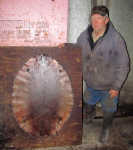- Missouri campgrounds resurgence (5/30/20)
- August a fantastic month for catfishing (8/11/18)
- Kayaking, canoeing good way to spend hot summer days (7/27/18)
- Hot weather means hot catfishing (7/7/18)
- Boat buyers have abundant options (6/16/18)
- Warm weather invites camping (6/9/18)
- Topwater fishing is a blast (6/2/18)
Regulated trapping beneficial to society
Saturday, January 10, 2015

Submitted photo/
Joe Duryee, a Bolivar fur dealer, poses with one of the many beaver pelts he has worked on this season.
It's the time of the year when a breed of outdoor people don't mind wading in icy water and cold temperatures to pursue their sport of trapping. More than 11,000 Missouri trappers face the challenge of catching a long list of furbearers with traps they have set.
A majority of Missourians approve of trapping (66 percent) as long as it is regulated. Regulated trapping provides many benefits to society, especially to maintain a balance between wildlife and people. Trapping benefits both people and wildlife. It benefits people by providing products people use every day. It benefits wildlife reducing overpopulation that leads to diseases.
It is a mistaken belief that fur is the only part of the animal used by society. Often, nearly the entire animal is used. Most animals caught by Missouri trappers are sold to fur buyers who prepare the fur for resale, market other parts of the animal and send the rest to animal by-products facilities.

Submitted photo/
Joe Duryee displays a good coyote pelt.
Both hunting and trapping has played an important part in the lives of Americans for the past 200 years. Both activities have provided food, clothing and income for Missouri families.
My first experience with trapping came while still a youngster, living in a small Missouri town. A neighbor who was in the army, came home for a 15 day furlough. Since he loved to hunt, fish and trap, I became very much interested in learning more about the trapping he did.
He made the most of the few days he had at home and invited me to tag along on several of his short trips. He hunted a little, which was okay with his wife. And when he mentioned fishing she hesitated a little, but consented for going just one time. He went twice.

Photo courtesy of the Missouri Department of Conservation/
A trapper gets a trap ready in the Missouri woods.
Then came the day he started tinkering with some of the traps he had stored away while he was in the service. After that, every time he passed the shed he gave the traps a wistful look and a friendly pat. The next afternoon he got down a dozen double spring traps and was ready to go.
After going a few miles outside of town he was in the country that he knew, places where he had trapped before. We walked a short distance to a small clearing where he set out the first trap, using fox lure for bait. A hundred yards down the trail, near an old railroad crossing, he made a small mound and set the trap at the edge of the mound forming a "V" or guide, to the trap.
The third set was made at the edge of the path and while making the set, some black birds where feeding nearby. He shot one and used it for bait. Just beyond the third set he made the fourth set in a spot where he had caught three bobcats and a raccoon the year before. The fifth set was made in an old orchard in a spot that had always produced. In fact, at this site he had caught one bobcat, three fox, three skunk and four raccoons.
The sixth set he placed a step-over stick to help put a furbearer into the trap. Heading back, he set the seventh trap in the water at the base of a snag in the small creek. Next, he took three traps, setting one of them in a clearing, covering it with leaves. The ninth set was set in the woods between two clearings. The tenth set was similar to the ninth. The final two sets were set on the way back near the old railroad crossing. After setting the 12 traps, we headed home.
When I reached home that afternoon, I felt that after having watched a veteran trapper set the first traps I had ever seen made ---- I must wait until the morning to see what they might hold.
I was ready to go at the first sign of daylight. The chill of early morning, eating breakfast in the kitchen ready to see what lies ahead, is something you never forget.
We checked all 12 traps and took two skunks and a gray fox. Nine of the traps were just as we had left them, but I returned home very well satisfied with the morning catch. After that experience, I can see the lure of trapping. It's not for everyone, but for the trappers in the state, it is a challenge and furnishes them fun and some profit.
Joe Duryee of Bolivar, started trapping more than 40 years ago. He is now a fur buyer who has seen a lot of changes in trapping over the years.
He said, "When I first started buying furs there, beavers and raccoons were the major animals trappers brought in. There were no otters and few bobcats unlike today. Our furs today go to the North American Fur Auctions, some go to North Bay, Canada, some are sold to dealers in New York and other parts of the country. I used to do a lot of business with Greece and Russia. A lot of the furs we get are from local rappers. There are a lot more wild animals running around here than most people think. "
Along with Bud Keller of Collins, who has passed away, Duryee has handled many thousands of local furbearers over the years. He had nothing but praise for Keller who he described as an honest man who did a lot for the fur business. He will be missed.
Duryee said there are more bobcats today than ever. The prices have gone up from $20-$30 to $120-$130 today. Fur prices fluctuate from year to year and species to species.
Among the hundreds of pelts in Duryee's building include badger, raccoons, beaver, muskrats, coyote, opossum, fox, otter and mink.
The fur market has its ups and downs. Prices for pelts range from $1.25 for opossum to $115 for bobcats. Jack Foster, Sedalia, is a veteran trapper who once told me that you have to love trapping because you won't get rich and you will find it is labor-intensive. There are a lot of non-financial pleasures trappers get out of their activity. In addition, there are many others including fresh air, exercise, peace of mind and the quietness of nature.

